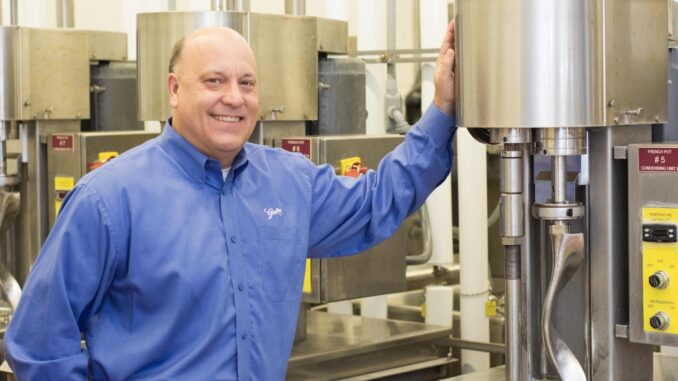
Graeter’s Ice Cream is quietly dominating its Midwest markets
by Lynne Thompson
Richard Graeter compares opening a pint of Graeter’s chocolate-chip ice creams—everything from Mint Chocolate Chip to its signature Black Raspberry Chocolate Chip—to unwrapping one of those long-gone Willy Wonka chocolate bars. But instead of looking for a Golden Ticket promising “tremendous things are in store for you,” devoted customers are hoping to find an enormous chunk of chocolate laced among its smaller counterparts.
The Cincinnati-based company’s president and CEO explains that unlike competitors that use uniformly sized chips made of “chocolatey stuff,” Graeter’s employs the same confectionary-grade chocolate enrobing its boxed candies. The melted chocolate, mixed with a little vegetable oil to soften it in its solid state, is poured into the ice cream during production, allowed to harden, then broken up into delightfully misshapen pieces from small to spoon-filling.
“In Cincinnati, whenever we’d get a complaint, it was ‘I’ve got a pint with no chips!’” he says with amusement. “Hey, people [were] exaggerating. They didn’t get a giant chip, but they got chocolate chips.” Conversely, newbies often assume that giant chip is a result of some production glitch. “I have to explain patiently to them, ‘No, you got lucky.’”
Those chocolate chips are just one of the things that have made Graeter’s a sweet obsession in the 150 years since the private enterprise’s founding, one that reported $70 million in gross revenues last year.
The ice creams—including flavors that do not contain chips—are scooped at 55 company-owned shops in Ohio, Kentucky, Illinois, Indiana and Pennsylvania and sold in over 6,000 stores nationwide. Graeter rattles off names such as Kroger, Whole Foods, Fresh Market, Meijer, Walmart and Giant Eagle. He points out that unlike so many craft ice-cream makers that have their products made for them by big co-packers, Graeter’s still makes its own, 2 1/2 gallons at a time—more than 1 million gallons a year—at its 25,000-square-foot plant in Cincinnati’s Bond Hill neighborhood.
“There’s a few ice cream companies that have been around longer than we have, but they’re not making craft ice cream,” he adds. “They converted to the modern methods, and/or they’re not family owned. So I can say without question we’re America’s oldest family-owned craft ice-cream company.”
Graeter’s was founded in 1870 by Louis Charles Graeter, who came to Cincinnati from his native Indiana as a teenager and began selling the ice cream he made in a street market. He opened his first store in the city’s Walnut Hills neighborhood four or five years later. But it was his third wife Regina, daughter of a prominent Austrian-immigrant businessman, who made the product a Queen City favorite after Louis died in a streetcar accident in 1920.
“Instead of selling [the shop] or folding, she took it on, took it over, and started running it with a passion,” Graeter says of his great-grandmother, who became a widow with two teenage boys to raise at a time when women couldn’t even vote. “In two years she did what Louis Charles couldn’t do in 50 years: open a second store.”
But Regina refused to adopt the continuous-process ice-cream machine, a 1926 invention that nearly doubled production by pumping air into the mix and yielding a cheaper, fluffier result. Instead, she began buying up competing shops forced out of business by centralized producers supplying grocery stores—Graeter estimates she had 17 locations at any one time—and moved her own ice-cream making from the shops’ back rooms to a 12,000-square-foot printing plant she purchased in 1934. There she continued Louis’ painstaking practice of making ice cream, 2 1/2 gallons at a time, in French pots.
“It’s a process that has been absolutely forgotten and lost,” Graeter says. “If we were not here, nobody anywhere would know what it is.”
Graeter describes a large metal bowl, 3 feet in diameter, in a wooden housing containing brine mechanically chilled by an ammonia-based system. As the bowl spun on a shaft mounted to its base, the ice-cream mix rose and stuck to the bowl’s sides. A worker repeatedly scraped the sides with a wooden paddle, returning the freezing mix to the center of the bowl so the process could be repeated until the desired consistency was achieved.
Over time the company replaced the pots with 37 stainless-steel counterparts cooled by a modern refrigeration system, all custom-made by a Cincinnati company. The design is actually based on an Italian gelato machine Graeter’s father Dick found in 1980 and the company subsequently modified when it proved too fragile for its needs. The worker with the wooden paddle was replaced by a blade. But the ice cream is still packed by hand to this day.
“When our ice cream comes out of a French pot, it’s thick, like peanut butter,” Graeter says. “Modern ice cream, because it’s still very liquid—like, foam—can be pumped into its containers at high speed.”
History suggests Willmer, Graeter’s grandfather, came up with the idea for making chocolate chips, broken up during the bowl-scraping process, during the 1950s. It was the modified French pot, however, that spun Graeter’s into other markets. In 1984 the first franchisee began making ice cream on-premises at a location in northern Kentucky. Five years later, another franchisee began doing the same in Columbus. By 2004 Graeter’s boasted 26 franchises in Kentucky, Columbus and Dayton, along with 12 company-owned stores in the Cincinnati area.
With this success, Graeter and his cousins Chip and Robert decided to expand the brand’s presence in grocery-store freezers. The ice cream already was in 20 local Kroger supermarkets.
“We beat Haagen-Dazs and Ben & Jerry’s combined in these stores,” Graeter recalls.
When Graeter’s approached one of the Cincinnati-based chain’s sales executives about putting its ice cream in other markets, he immediately agreed. The product arrived in Denver-area stores in 2008. Sales there put the brand in Texas, then in Kroger locations nationwide.
“Very quickly, we ate up that excess capacity,” Graeter says. “We were now selling every drop we could possibly make.”
In 2010, Graeter’s expanded the Bond Hill plant. The new plant began supplying all of its company-owned locations with ice cream as well as Graeter’s continued new locations. Graeter describes the ideal spot as a larger community in the Midwest—a region of the country where sales in other retail outlets already are strong—near family-filled neighborhoods, with enough space for outdoor seating and a drive-thru.
“By having brick-and-mortar stores where we have [a presence in] grocery stores, our brand becomes very dominant,” he explains.
Each store is staffed by employees trained to provide what Graeter calls “a first-class customer experience.”
The ice cream, however, is the main draw.
Varying selections of “core” flavors are available at Graeter’s shops and other retailers at any one time, from Madagascar Vanilla Bean to S’mores. They are augmented by seasonal flavors like Pumpkin, Eggnog and Peach, sold for a couple of months each year; limited-edition counterparts that run seasonally; and summertime “bonus flavors” scooped at shops until they’re gone.
Some develop from ideas pitched by ingredient suppliers and customers or a desire to honor local institutions and their milestones. A recent example is Boldly Bearcat, a limited-edition tribute to the University of Cincinnati’s bicentennial consisting of a vanilla base, red-velvet sandwich cookies and chocolate chips.
“It’s kind of a messy, organic, all-over-the-place process,” Graeter says.
The company is looking to expand its dominance in Indianapolis, which Graeter believes could eventually support 10 stores instead of the current three. He also is considering opening stores in Florida, which many Midwesterners call home for six months of the year, at some point in the future.
“I call the strategy Fortress Midwest,” he says. “I want to own the Midwest, make sure we’re No. 1 in every Midwest market.”



